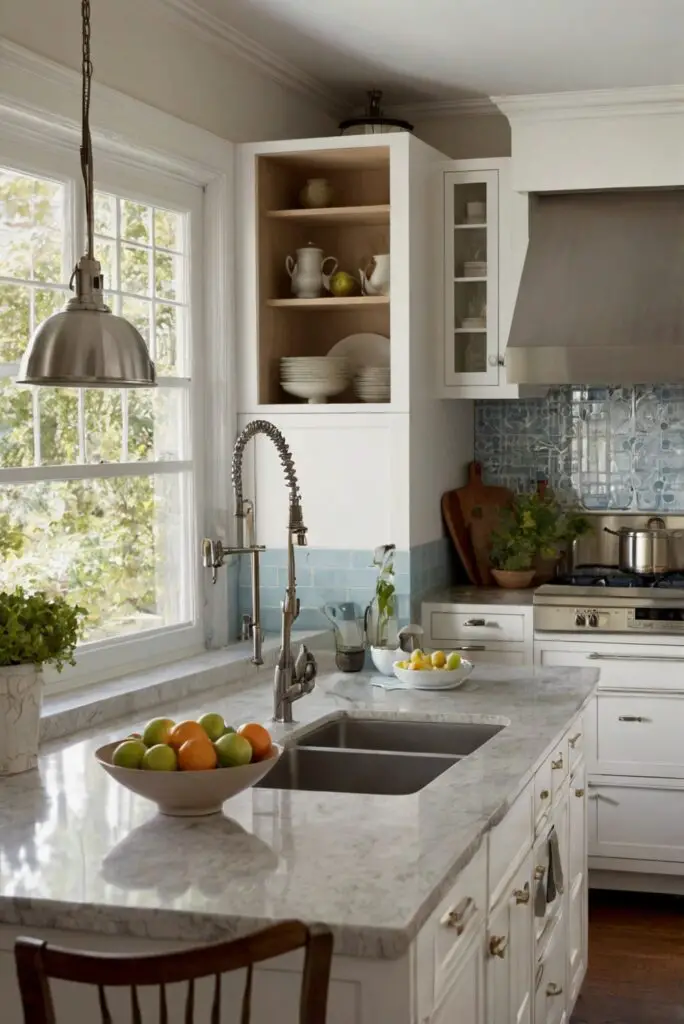Discover how the strategic use of color can transform your open-plan kitchen, creating distinct zones for functionality and style.
Using color to define zones in an open-plan kitchen is a common approach in home interior design. By utilizing different paint colors or hues for various areas, such as the dining, cooking, and living spaces, you can visually separate these zones while maintaining a cohesive look throughout the room. When working with an interior designer, it’s essential to discuss color options that complement each other and create a harmonious atmosphere. Selecting a color palette that suits your taste and style is key, as well as ensuring proper color matching for walls and furniture. Home paint colors should be chosen carefully to enhance the overall decor of the space and reflect your personal preferences. Interior designers specializing in kitchen designs, living room interiors, and color matching painting can provide valuable insights on how to effectively utilize color to define zones in an open-plan kitchen.
How can I use color to define different zones in my open-plan kitchen?
Using color is a powerful way to delineate zones in an open-plan kitchen. To define different areas effectively, consider using bold colors for important features such as kitchen islands, dining spaces, and cooking areas. For example, you can use a vibrant color for the kitchen island to make it stand out and act as a focal point. This helps create a visual distinction between zones and guides the flow of movement in the space.
What is the best way to choose colors that enhance the flow of my kitchen space?
My Lovely Spring Paint for 2025
Ready for a Spring Makeover? Explore the Freshest 2025 Paint Trends!
White Sage/Green SW Pistachio green Soft blue Honeysweet/Orange Pink Sugar Sage Tint BMAs an Amazon Associate, I may earn a commission from qualifying purchases at no extra cost to you.
When selecting colors for an open-plan kitchen, it’s important to choose hues that promote a sense of harmony and continuity. Consider using a cohesive color palette that ties all the zones together while still allowing each area to maintain its individuality. Neutral tones can serve as a foundation, with pops of color used strategically to define specific zones and create visual interest.
Can I use different shades of the same color to create a cohesive look in my kitchen?
Using different shades of the same color is an excellent way to achieve a cohesive look in an open-plan kitchen. This approach creates a harmonious atmosphere while still providing variation and depth. For example, you can use light and dark shades of blue to distinguish between the cooking area and dining space. By maintaining a consistent color family, you can ensure that the various zones blend seamlessly together.
What colors complement each other well when dividing zones in an open-plan kitchen?
When dividing zones in an open-plan kitchen, it’s essential to choose colors that complement each other harmoniously. Consider using contrasting colors to create a visual separation between different areas. For instance, pairing warm tones like red and orange with cool tones like blue and green can create a dynamic and balanced color scheme. This contrast helps define zones while also adding visual appeal to the overall space.
How can I incorporate accent colors to add personality to each zone in my kitchen?
My fAV Spring DECOR for 2025
Discover Spring’s Best 2025 Decor Combinations – Perfect for Any Room!
Oversized Indoor Plants White Curved Sofas Rugs BOH Brown Cream Moroccan Hype Boho Rug Outdoor Patio Furniture Sets Topfinel Pillow CoversAs an Amazon Associate, I may earn a commission from qualifying purchases at no extra cost to you.
Incorporating accent colors is a great way to infuse personality and character into each zone of your open-plan kitchen. You can use accent colors through accessories, artwork, textiles, or even small areas of wall paint. For example, adding vibrant throw pillows in a bold color to the dining area or hanging artwork with a pop of color in the cooking zone can help to personalize and differentiate each space.
Are there specific paint colors that work best for delineating zones in an open-plan kitchen?
While there are no hard and fast rules for paint colors in open-plan kitchens, certain shades can be particularly effective for delineating zones. Neutral tones like grey, beige, and white work well as base colors, providing a versatile backdrop for different zones. Bold colors such as deep blues, rich greens, or warm yellows can be used strategically to define specific areas and create visual impact. Experimenting with different shades and tones can help you find the ideal colors to delineate zones in your kitchen.
Why is it important to consider lighting when choosing colors for different zones in an open-plan kitchen?
Lighting plays a crucial role in how colors are perceived in a space, especially in an open-plan kitchen. Natural light can enhance or alter the appearance of colors throughout the day, so it’s important to consider how lighting conditions will affect the chosen color palette. Additionally, artificial lighting, such as pendant lights or under cabinet lighting, can be used to highlight specific zones or features in the kitchen. By taking lighting into account when selecting colors, you can ensure that each zone is showcased in its best light.
Key Takeaways
– Using bold colors for key features helps define zones in an open-plan kitchen.
– Choose a cohesive color palette with variation to enhance flow and visual interest.
– Different shades of the same color can create a cohesive look while adding depth.
– Contrasting colors can be used to delineate zones effectively in the kitchen.
– Accent colors personalize each zone and add character to the space.







